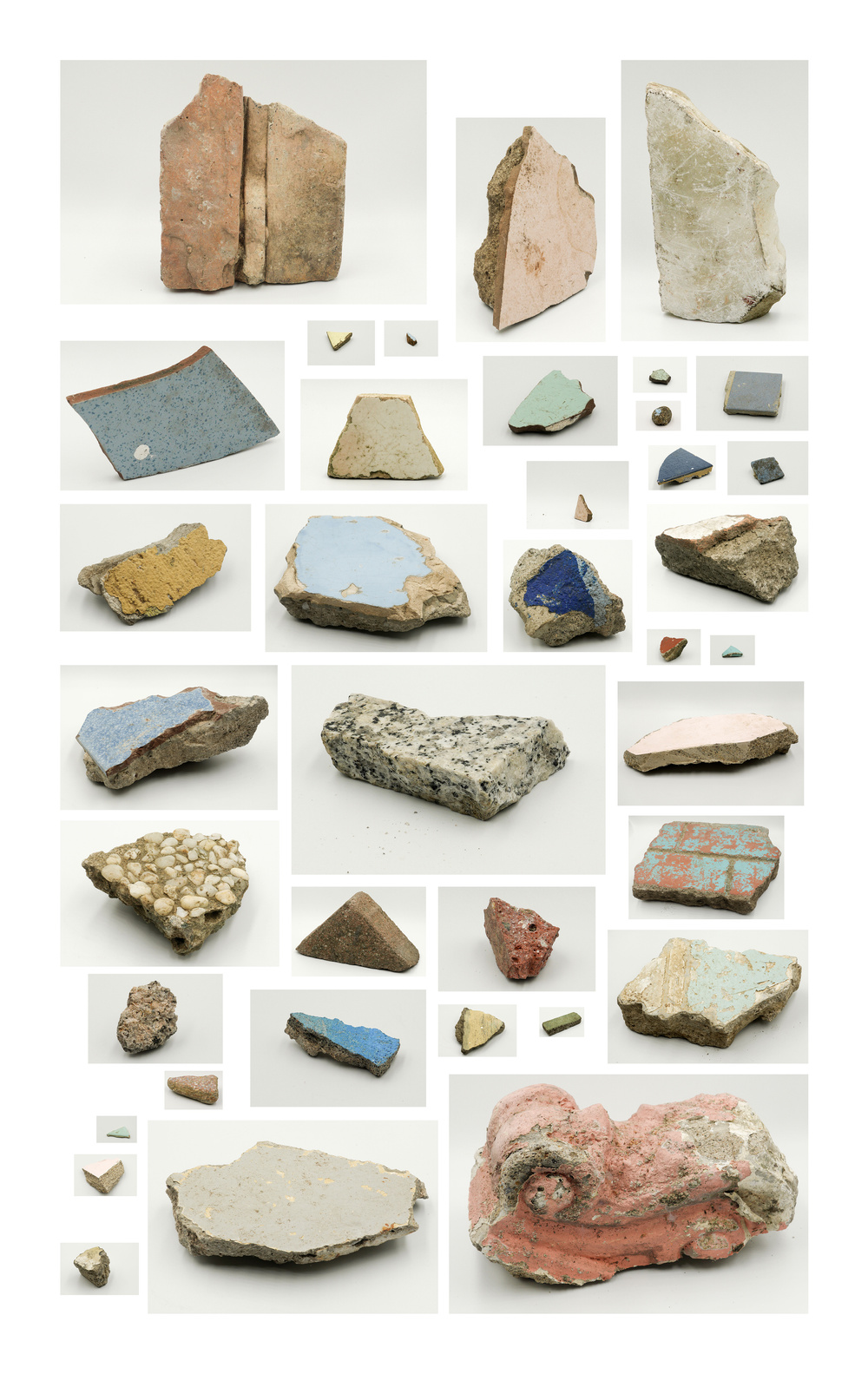Lesley-Anne Cao is an artist based in Quezon City, Philippines. Apart from her degree in Fine Arts from the University of the Philippines, she also attended the École nationale supérieure des Beaux-Arts (ENSBA) in late 2013 – early 2014 as an exchange student. At present, she is an archivist for Green Papaya Art Projects and Asia Art Archive. Learn more about her work at: www.lesleyannecao.site
I met Lesley in 2010 at the University of the Philippines. We were both applying to become members of the UP Writers Club, a literary organization established in 1927. Our application was successful and it opened the opportunity to get to know each other. She was studying painting at the College of Fine Arts and I was under the art history program of the Department of Art Studies at the College of Arts and Letters. We both graduated in 2014 and have pursued our respective careers since.
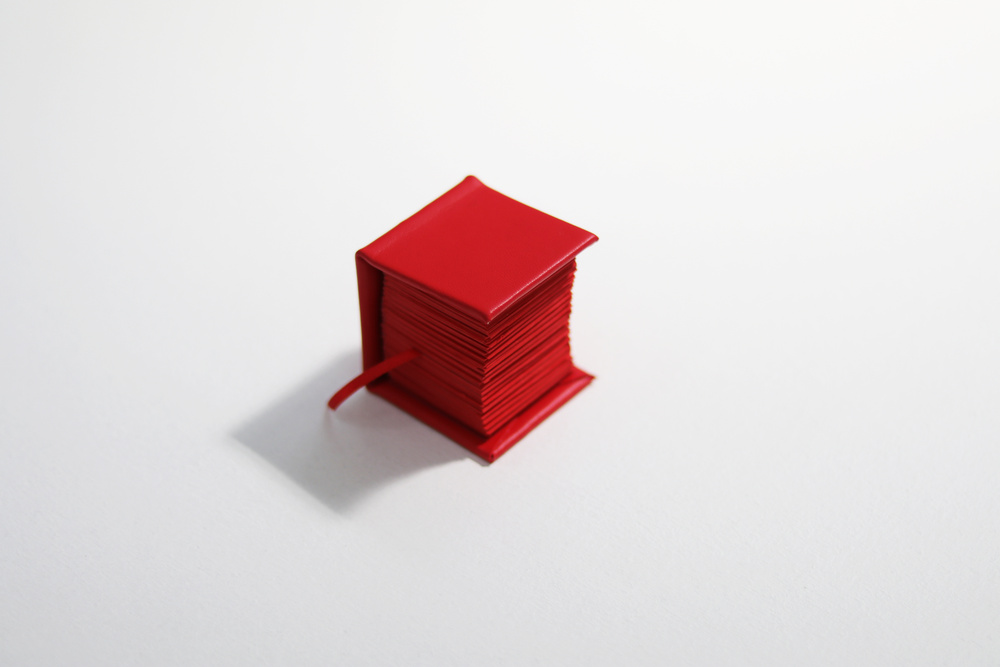
Bonsai
Handbound book: 400 pages, 2 x 2 x 2.2 in / 5 x 5 x 5.6 cm
2018
Zeny May Recidoro: What was the process you underwent in becoming an artist?
Lesley-Anne Cao: I think this is where the idea of ‘proto-practices’ come in… I drew and painted (with watercolors) as a child, like most children, and it continued until I was in highschool. I also wrote poems in my dad’s computer and in notebooks when I was in highschool. I began taking photographs on film when I was in grade 6. The first camera I had was an Olympus point-and-shoot my mom bought while she was studying in Japan. But it never occured to me to call any of those activities as making art or that it was going to lead me to become more serious in ‘making art’. I think that consciousness of being an artist only began when I was in college, in art school. I thought about it more and began to entertain the idea. I attended this class when I was in 3rd year [college] where a much older classmate shaded me because I said that I didn’t see myself or didn’t think of myself as an ‘artist’. So they said, “why are you here then?” But I think back then I was still intimidated with the idea of being an artist. Now, I think that even those who are active on deviantArt or those who post calligraphy on instagram, if they call themselves artists then they’re artists. And thinking about that helps me see and think of myself as an artist, too.
I also remember, when I was a kid I had this library I called Silvery Library. And I was so serious about it! I had inventories of books. Each book had an envelope and card at the back, where I wrote made-up borrowers’ names. The date stamps were also made-up. It’s weird to think that this fantasy library informs what I’m doing now as an adult.
Even playing with plants or the idea of plants was part of my explorations as a child. It’s kind of amazing to think that that also comes into my artistic work, and the only thing that’s changed are the scale and circumstances.

Untitled (Book for weeds)
Printed and handbound polytarp sheets
20 x 13 in / 50.8 x 33 cm
36 pages
2018
ZMR: I saw the progression of your work since we met and became friends at UP [University of the Philippines]. Were the shifts deliberate (I mean, from the art you used to do— perishable, often sculptures or works that to me deal with detritus (that you use them literally as materials), to the current ones that are more ornamental, jewelry-like?) or did you play it by ear, so to speak? Sorry, I know describing your latest works as ornamental and jewelry-like are inaccurate.
LAC: The shifts weren’t deliberate. Though with each work there’s always a lot of thought that goes into what it’s going to be in terms of materials used, process, etc. But it’s true, for me they’re not so different from each other. Because even though they may appear as ornamental or jewelry-like, in a sense they are still detritus [that my works are made, wholly or in part, of detritus materials]. So, I guess yes and no? The choice of material is always deliberate, as well as the process, but part of it is also always playing by ear. If that makes sense.
ZMR: Yeah, it makes sense.
LAC: Because I never really know what I’m going to do or what will happen to the work. It’s hard to tell what the next steps, the processes are going to be, how much time I will devote to the work, and how long it will take [to make new work]. At the same time that I’m maintaining a day job.
ZMR: It’s makes me happy to watch that progression [and be a silent part of it]. Sometimes, I barely realize how long we’ve known each other… It’s still interesting for me how you use detritus in your works. Especially with your [undergraduate] thesis exhibit. I remember you took me there and we took photos posing with your sculptures. I think it was then that I realized we were artists, or you are an artist and I am some kind of writing functionary [I previously spoke of it in the past tense, as if our careers are done!]… What informed you to use detritus for your materials? I guess this is a poetics statement and a cornerstone. I think, since your process and your works will still undergo many changes [in the coming years].
LAC: Oh yes, it’s our first decade [as friends] next year.
I think it comes from my interest in the everyday and how ordinary it is, because it becomes a place for me to ask questions about how much I don’t understand and why it’s interesting for me how [the everyday] is bound to sensation, in holding and handling things.
Detritus is interesting for me because everyone knows [or has an experience] with it. It looks and feels familiar, especially if it is detritus of the body, the city, and of everyday objects.
I think it has rich potential as material because it’s like the language that everyone knows or understands, or at least among the people within my context, you can say so much but also choose to not reveal so much.
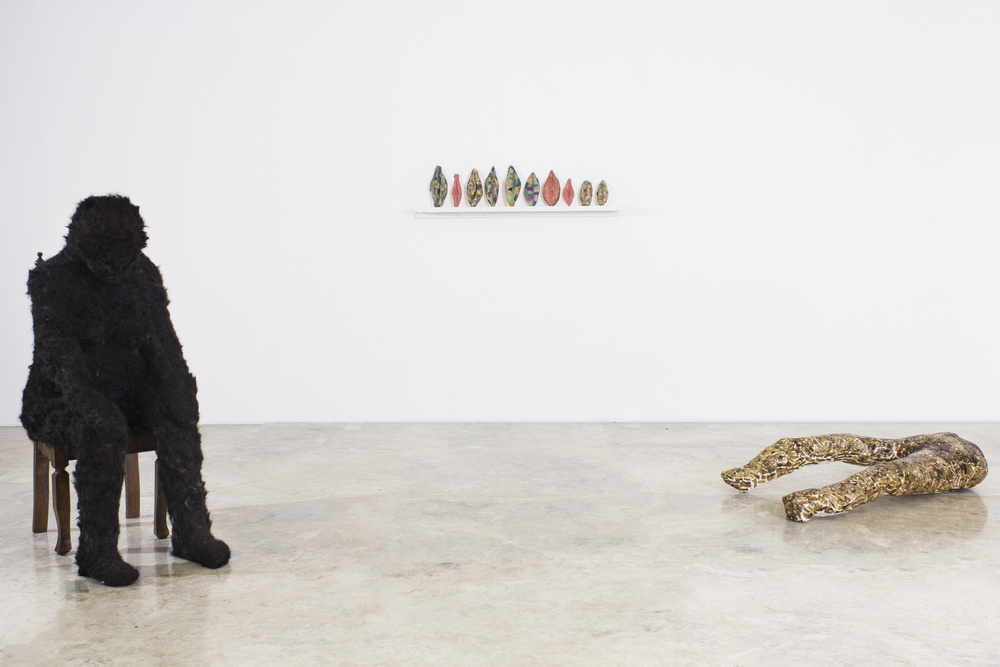
Objects
Hair, dehydrated apple skin, bubble gum, plaster, wood
2014
LAC: Grabe [‘grabe’= colloquial superlative expression, like “oh my god!”; same energy as “what the fuck!” but joyful], to think that we’ve been friends for a decade! Love you, Zeny. I want to send you something, please send your address to me sometime.
ZMR: Okay, later. You too. I bought these pretty stamps [from USPS] and it’s a beautiful excuse to use them.
LAC: I don’t know if any of what I’m saying makes sense or if they are lacking. Let me know!
ZMR: No, they’re all good. Do you make a distinction between being a writer/poet and artist?
LAC: Yes and no. I don’t think of myself as a poet at all. I also can’t say I’m a writer though I can say that if needed. But when I do work with text, even with a work I insist is a ‘poem’, for me it still belongs to the core of my work as an artist.
ZMR: Is there any one artwork that continues to move you?
LAC: Hala [loose trans. = ‘uh oh’], there’s a lot.
ZMR: Just give me one, the most-most if any.
LAC: I guess the best answer is the paintings of Rene Magritte. I’ve liked his work since I was young. I saw it in books and on the internet, and I was lucky to see them [in person] in many other places. There is always a physical and mental response, I can read it easily yet there could also be a challenge. I also want to say the works of Lani Maestro. For me, there are similarities between her and Magritte, and my responses to their works. Sometimes, even if somebody just talks to me about Lani’s works, it feels as if I have experienced the work. That’s the kind of work that is most moving for me.
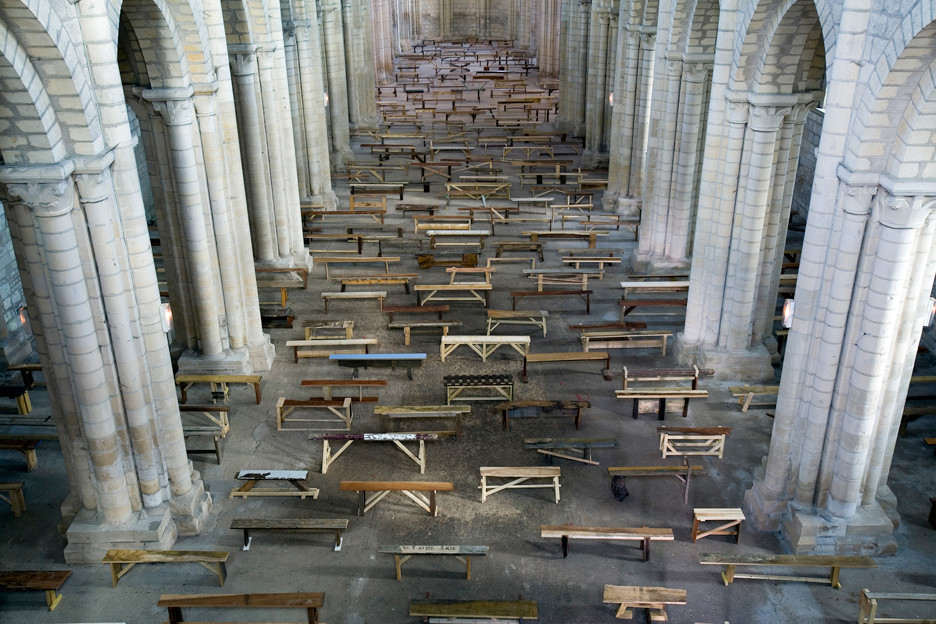
Je suis toi
Installation with recuperated wood
Eglise Saint Nicolas, Caen, France, 2006
ZMR: It’s not easy pursuing creative or cultural work in the Philippines— were there intense challenges that you have dealt with?
LAC: I don’t think of them as ‘intense’, but rather prolonged. That on occasion they become sharp pain, but generally a dull ache. The most challenging thing for me so far is to maintain my day job and ensuring that there’s enough physical and mental energy left in me to develop work. For many of my peers, it’s challenging to look for a day job or racket in the first place and it’s a source of so much anxiety for me to think about job security. And I always need money to produce work, because even if I use detritus or cheap materials, they are always coupled with pricier materials or paid services from other people. It’s hard to get funding for making [art] especially since local grants are so limited, right. And the bureaucracy, too, I’ve found challenging. The very process of applying for a Visa is so expensive and so strict. Even when you’re the one who’s been invited? We really deeply feel this need to jump through flaming hoops, and you just want to present some work (and be present). It’s kind of detrimental to [our] dignity to have to beg to be allowed to even be there.
ZMR: [Note: I specifically framed the previous question as being an artist in the Philippines. But it is also acknowledged that these challenges are present anywhere, perhaps only varying in degrees of pain. Text from a portion of our conversation no longer included but I also shared with LAC the difficulties of going through the process of scholarship. Despite the prestige, what is felt is constant questioning, insecurity, and being corroded, on a daily basis, by anxiety. How long can this be maintained? What happens when something falls through? What can be done? Am (I) good enough? We march on.]
We’ve scrambled around so much in order to produce work and to ensure that the conditions are tenable enough for us to produce even a fraction of our ideas— what was the most edifying piece of validation you received from anyone?
LAC: According to my natal chart, I’m a Capricorn moon. That means I seek guidance from mentors. There are instances when my mentors (artists whose works I follow and who I look up to and deeply respect) are the ones who look for a space for me and my work, even when they got nothing or will not get anything in return.
Even the conversations they have with me regarding my work. And even if I call them my ‘mentors’, I do not feel as if we are subject to a hierarchy, that we are not equal in footing. But I don’t know if that means validation per se.
I think it counts as validation.
I guess I just want to clarify that I’m not a wide eyed follower. There are people who are turned off by the idea of having a mentor and being a mentee precisely because it implies a hierarchy and indebtedness.
ZMR: I agree with that. As always, there’s a way to honor institutions without being its pet. I think it’s important to have a degree of detachment. A respectful distance or distant intimacy. Like a cat.
LAC: I completely agree.
ZMR: I just said to not be a pet but my analogy is a cat, ano beh (ano beh=colloq. something like, ‘gurl what?!’)
LAC: Well, that’s right. In this case, it’s better to be a cat than a dog.
ZMR: I remember a time when you became interested in book making. Are you still pursuing that?
LAC: Yes. I still want to make books after the last 2. Bonsai was placed in a library and it makes me happy to think that many people, especially children, will be able to see and read it. I have some other ideas saved up for other books, which I might do in 2020! Not now, because that’s not the [form] asked for by my works in progress.
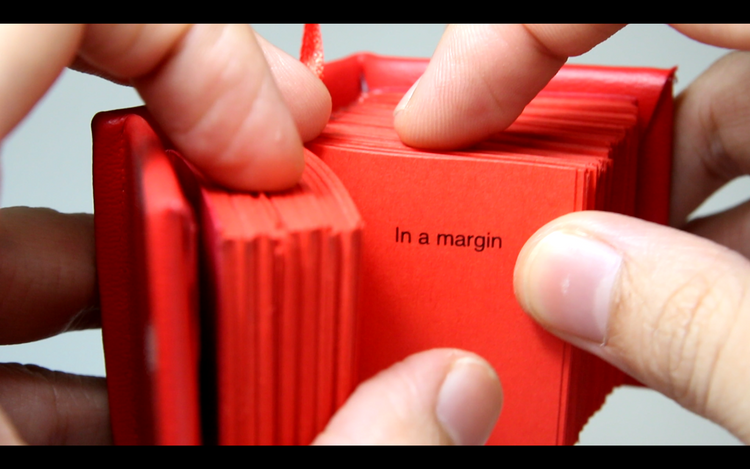
Single-channel video: 10 min 15 sec, no audio
ZMR: Light question: best moment that you experienced recently?
LAC: Recently, we cut Pig’s hair real short [Pig is LAC’s pet dog] and I was so happy. It was as if I was seeing his young self, but when I remember that he’s old I’m no longer sad just excited to know that we still have some time to spend together. I think most days it’s much more fun to look at dogs than art. Sometimes they have more power to move me or to make me think.
ZMR: That’s true, I think.
I think = I feel that with any non-human being [under which, ironically, art could be included even if it’s a human product].
LAC: Best moments indeed.
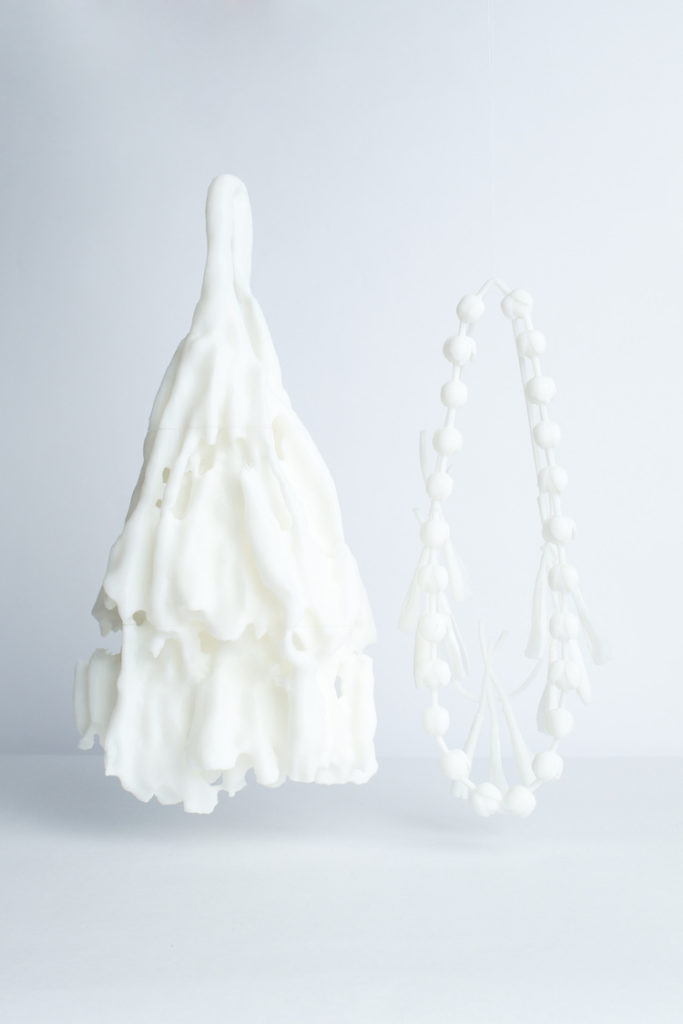
Dust (zinc alloy, plastic beads, sterling silver, PLA filament, thread, string, cord, rope)
2019
